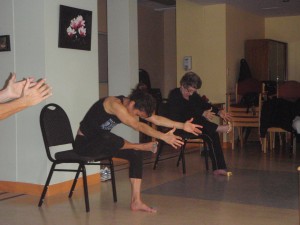Yoga is a term used to describe a range of traditional systems of physical exercise and meditation derived from ancient India. The term is derived from the Sanskrit term yuj, meaning “to join” or “to yoke.” It refers to the discipline of aligning the mind, the body, and the spirit.
When most people today use the word yoga, they’re generally referring to the physical exercises, which comprise a variety of body postures (asanas) and breathing techniques (pranayama). Together, these have become popular as a kind of low-impact physical exercise, and are increasingly used by older adults for various health purposes: relaxation; physical and mental fitness; illness prevention; and disease management.
Depending on the type of yoga being practiced, aspects of meditation and spirituality are sometimes incorporated, but most people who practice yoga focus mostly on the body postures and breathing exercises. Despite its historical roots in Hinduism, modern yoga is not a form of religion.
Chair Yoga
Although traditional yoga exercises can be very beneficial, I have found that one of the best types of yoga for older adults is chair yoga. This is an adaptation of regular yoga in which exercises are done while sitting or holding onto a chair, rather than sitting on a yoga mat on the floor. By providing extra stability, the chair reduces anxiety and makes yoga a safe exercise for most older adults. Make no mistake, though: Although the chair replaces the mat, chair yoga still provides a challenging workout that is sure to improve your health!
Anyone that can sit in a chair can benefit from chair yoga; it is suitable for men and women of all abilities, including those with physical limitations or restrictions. It is safe and beneficial for people with a range of health issues:
- hypertension (high blood pressure)

Annette leading chair yoga group
- vertigo (dizziness)
- arthritis
- osteoporosis
- back problems
- multiple sclerosis
- menopause
- fatigue
- carpal tunnel syndrome
- chronic pain
- anxiety
- depression
Chair yoga encompasses all aspects of an individual: physical, emotional, mental, and spiritual. Chair yoga increases strength, flexibility, concentration, balance, energy, range of motion, breathing capacity, circulation, and confidence. It is perhaps for these reasons that chair yoga can help reduce the risk of falls and other injuries. Chair yoga also encourages quiet reflection, relaxation, proper breathing, good posture, and a sense of well-being.
When you take private, in-home chair yoga lessons with me, you will learn modified traditional yoga poses and new breathing techniques. When you take one of my classes, you will also experience the benefit of practicing yoga in a supportive group atmosphere. Although some of my classes incorporate a spiritual component (e.g., Shabbat yoga for Jewish older adults), most classes focus on the physical exercises and are therefore open to spiritual and non-spiritual people alike.
Chair yoga requires no prior yoga experience. All you need to do is come with loose-fitting, comfortable clothes and a willingness to improve your body and mind.
If you’re still not sure whether yoga is right for you, consider reading my list of Yoga Myths and Misconceptions. This might help convince you to give yoga a try!
For more Chair Yoga information check out the article in the January 2014 issue of SENIOR LIVING magazine (p.23)
To see what chair yoga looks like in action, take a look at the following video:



